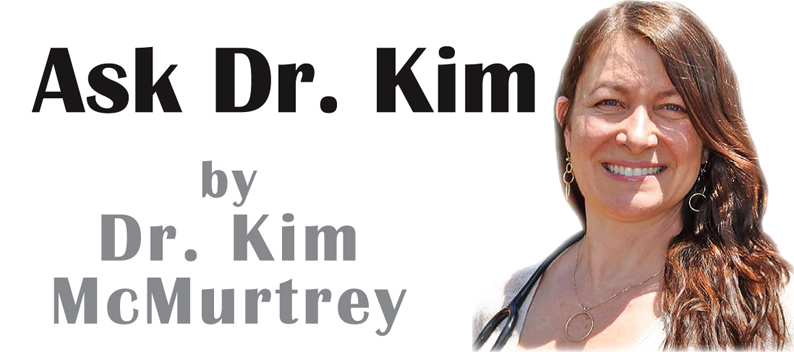Dr. Kim talks endocrine disruptors
Published 8:10 am Friday, May 31, 2019
From Elena in Johnson City: Hi Dr. Kim, I have noticed that every time I go to the salon to get my hair colored I usually leave with a headache that starts behind my eyes and ends up all over my head. My friend says it is from endocrine disruptors in the salon. What are those and how can I avoid them?
Hi Elena,
Endocrine disruptors are a health concern that are not talked about enough. Your headache may be due to endocrine disruptors, or it may simply be due to strong fragrances or noises from music and hair dryers in the salon. In this article I’ll explain the background of endocrine disruptors and how you can minimize exposure to them.
An endocrine disruptor is any chemical that interferes with the normal hormones of the human body. They can come from plants or synthetic chemicals. The most concerning endocrine disruptors are the ones that have hormone-mimicking effects (think of how soy mimics estrogen). There are hundreds of potential endocrine disruptors existing in various chemicals for everyday use: in beauty products, cleaners, fabrics and materials, even in food. There is very little data on exactly how many there are.
If you are worried about endocrine disruptors in the hair dye, it is best to ask what kind of dyes your salon is using and then research the ingredients. Your salon may be able to order a more natural dye. It might cost a little extra.
The movement in beauty services and products to reduce their chemical components is still in the early stages. It is really just beginning. Many chemicals are used in salon products because organic and chemical-reduced products can be very expensive, and there is little regulation on which chemicals are allowed. Also, there is little mentioned in the news and no education provided to the public about chemicals which can adversely affect health. To find the information it is necessary to ask a health practitioner (like myself) or do your own research. For example, many of the chemicals in hair products, which the salon workers are exposed to daily, come from coal tar. The coal tar can hide under its chemical names, “Aminophenol” or “Diamenobenzene.” In Europe, it is banned from use in hair dyes because of its connection to cancer.
There is something you can do if you are worried about endocrine disruptors. Becoming aware of them is Step 1, and Step 2 is to reduce your own use of the chemicals. In beauty products the four main chemicals to watch out for are the four Ps: Parabens, Plastics, Pesticides, and Phthalates.
Parabens are preservatives in many beauty products and items sold in plastic containers. They mimic estrogen in the body and also tend to build up in the hormone-producing glands. They are thought to be carcinogenic and interfere with the neurons of the brain.
The second category, Plastics, also mimic estrogen because they contain the chemical xenoestrogen. The most problematic of these is BPA — Bisphenol A. Many salons and companies are switching to glass containers or BPA-free plastics. A wise choice, since BPA ends up in the ocean and further endangers the health of people and the planet.
Phthalates is the category that probably caused your headache. It is a chemical found in synthetic fragrances, and can either be in the plastic container or mixed into the fragrance itself. Phthalates name on labels is “parfum,” not to be confused with “perfume” — they are solvents and have nothing to do with the actual fragrance, but are thought to extend the shelf-life of products with fragrance. Even if the products contain no phthalates, strong smells that you’re not used to can sometimes cause headaches.
The “new car smell” is due to phthalates, but their usefulness lies not in scents, but in building materials in everyday objects. Phthalates are used in vinyl flooring, medical equipment such as IV tubes, paints, and pipes. It is impossible to avoid all phthalates, so a good strategy is to choose products which are labeled “phthalate-free.”
Pesticides are often added to botanicals used to create fragrance in beauty products. They are added to every plant not listed as “organic”— even to plants that are naturally pest-free, such as lavender and rosemary. Pesticides are concerning because there is no way to wash them off of the plant before use, and many of them are known neurotoxins.
There is not much available research on how different endocrine disruptors mix together in combination to impact health or disease. For example, we don’t know how a dose of parabens will interact in someone who is regularly exposed to many phthalates. The best strategy to reduce exposure is to choose organic products for use at home, reduce beauty products that contain any of the four Ps, and limit exposure to synthetic fragrances and plastic.
————
Dr. Kimberly McMurtrey DNP, APRN, FNP-C is the Primary Provider at Tri Cities Health, located on West Elk Ave., Elizabethton. If you would like to submit a question for her to answer you can call 423-543-7000 or email your questions to tricitieshealth@outlook.com.
**Medical Disclaimer: The information contained in this column is not intended or implied to be a substitute for professional medical advice, diagnosis or treatment.






